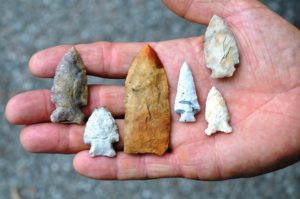Photography courtesy of Lowell Washburn, all rights reserved.
For America’s earliest hunters, archery equipment was a matter of survival
For archery deer hunters, November is the grandest month of the year. In Iowa, as elsewhere, bow hunting has enjoyed a tremendous surge in popularity during recent decades. More than 60,000 archers are pursuing deer in Iowa this year. Sporting goods manufacturers have responded to the boom by offering hunters an unprecedented array of products that all but guarantee the buck of your dreams. Obtaining the best in today’s gear and gadgets is as easy as making an online visit to your favorite outdoor retailer. The only limits are imposed by the thickness of your wallet.
It hasn’t always been this way, of course. For America’s earliest hunters, having the best equipment was more than a Saturday morning luxury. It was, in fact, a matter of survival. Acquiring that equipment was no easy task. Arrowheads are a good example. When ancient hunters first crossed the land bridge into North America there were no razor sharp, stainless steel broadheads. No mechanical, open on impact arrow points. There was no Cabela’s, Amazon, or internet shopping. Hunting equipment – every bit of it — had to be handmade. Arrowheads were literally chipped from stone. This do-it-yourself process was not as crude as you might imagine.
Although rudimentary in design, the arrow easily ranks as one of humankind’s most important inventions. The first arrows [also known as darts] were constructed from heavy, three-foot-long shafts and used in conjunction with wooden cradles known as atlatl. Commonly referred to as a ‘spear chucker’, the atlatl endowed human throwers with enhanced mechanical advantage, allowing darts to be hurled with enough energy to bring down large game, including such massive creatures as elk, bison and mammoths.
The perfection of the bow gave birth to a scaled down version of the dart; a lightweight projectile we would quickly recognize as the modern-day arrow. Lighter, faster, and more accurate; the bow and arrow soon replaced atlatls as the weapon of choice.
Most early arrows were armed with stone points. But working raw stone into usable products was labor intensive and unpredictable. Over time, early hunters discovered that manufacturing problems could be greatly reduced by heat-treating raw stones. Heat processed stone could be fashioned into stronger, thinner and sharper arrowheads.
Heat treating dramatically alters the physical properties of raw stone. Might not sound like any big deal to you and me. But for aboriginal hunters it represented a quantum leap in equipment technology. Better equipment meant more food and greater survival.
Handed down from generation to generation, heat treating became its own art form. The process began by burying untreated stones – usually chert or flint — beneath three or four inches of sandy soil. Once rocks were covered, a fire was ignited over the top. The pit site needed to be as dry as possible. Soil moisture could cause hairline rock fissures to expand and explode, completely ruining any potential the stone may have held. Temperature control was critical. If rocks became too hot, the material would weaken rather than strengthen.
To avoid overheating, indigenous artisans learned to push glowing embers to the outside edges of the fire pit. Circular in design, this original Ring of Fire allowed for improved temperature control and enhanced results. After coals burned to ash, the buried stones were allowed to slowly cool for two to three days. Patience was key. Accelerated cooling produced the same losses as overheating.
Once cooled, the treated stones were extracted, and the knapping process began. Hunters used blunt tools, such as smooth rock or elk antler, to initially flake away large chips of stone. Under the hands of an experienced craftsman, arrowheads rapidly took shape. Finishing touches were achieved by using smaller tools, such as antler tips, to pressure flake smaller and smaller chips until the head’s desired size and shape emerged.
To achieve maximum cutting potential, stone broadheads needed to have rough, rather than smooth, edges. The finished product was a serrated point that could cut your hand if carelessly mishandled. Primitive broadheads were more than capable of producing lethal, double lung penetration on deer, elk and pronghorn. When shot from stiff Plains-Style bows, arrows that hit no bone could completely pass through a running bison.
Times change. And when it comes to archery equipment, they’ve changed dramatically. Today’s bow hunters live in a world of high-tech mechanical bows, warp speed arrows, and assembly line broadheads. That’s all well and good. But it is also unfortunate that in the face of all this advancement, much of our archery heritage has been lost to time. Although few modern-day archers would be interested in hunting with homemade wooden bows and flint tipped arrows, the ancient tools remain as capable of putting meat on the table today as when primitive, skin clad hunters first crossed the Siberian land bridge into North America. For thousands of years, the bow and arrow provided humans with food and defense. Regardless of what equipment they choose today, contemporary bow hunters should at least be aware of archery’s rich and colorful heritage.
LW








 Tom Cope
Tom Cope Sue Wilkinson
Sue Wilkinson Susan Judkins Josten
Susan Judkins Josten Rudi Roeslein
Rudi Roeslein Elyssa McFarland
Elyssa McFarland Mark Langgin
Mark Langgin Adam Janke
Adam Janke Joe Henry
Joe Henry Kristin Ashenbrenner
Kristin Ashenbrenner Joe Wilkinson
Joe Wilkinson Dr. Tammy Mildenstein
Dr. Tammy Mildenstein Sean McMahon
Sean McMahon